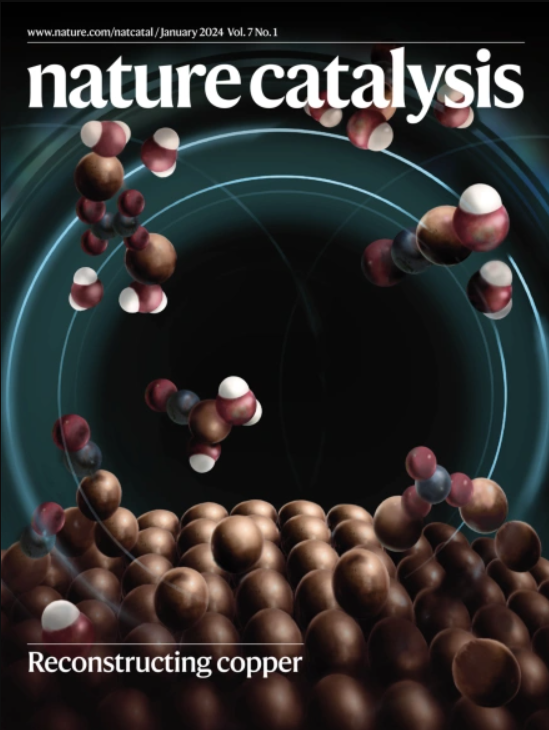Copper-catalysed enantioconvergent O-alkylation of alcohols with racemic α-tertiary haloamides to access enantioenriched hindered dialkyl ethers
IF 44.6
1区 化学
Q1 CHEMISTRY, PHYSICAL
引用次数: 0
Abstract
The cross-coupling of bulky electrophiles and nucleophiles to form sterically congested molecules is a challenging issue in modern synthetic chemistry. Among them, chiral hindered dialkyl ethers are one class of valuable motifs, but the catalytic asymmetric synthesis of such motifs from readily available tertiary alcohols and racemic electrophiles remains underexplored. Challenges arise from the steric hindrance of both reactants, the difficulty in enantiodiscriminating the three substituents of tertiary electrophiles and the low nucleophilicity of bulky alcohols. Here we show the copper-catalysed enantioconvergent radical O-alkylation of diverse alcohols with racemic α-tertiary haloamides to access enantioenriched hindered dialkyl ethers. Successful realization of this strategy relies on the development of anionic N,N,N-ligands with a side arm to form coordinatively saturated key Cu(iii) intermediates, therefore exerting remarkable chemo- and enantioselectivity. The synthetic potential is showcased by the late-stage functionalization and stereodivergent synthesis of four stereoisomers of a product with two stereocentres. The O-alkylation of tertiary alcohols with racemic tertiary electrophiles to access chiral hindered dialkyl ethers has remained elusive. Now this synthetic challenge has been accomplished by copper-catalysed C–O cross-coupling between tertiary haloamides and alcohols using designed ligands.


铜催化醇与外消旋α-叔卤酰胺的对映收敛o -烷基化反应得到富集对映体的受阻二烷基醚
在现代合成化学中,庞大的亲电试剂和亲核试剂的交叉偶联形成空间拥挤的分子是一个具有挑战性的问题。其中,手性受阻二烷基醚是一类有价值的基序,但从现成的叔醇和外消旋亲电试剂催化不对称合成这类基序的方法仍未得到充分的研究。挑战来自于两种反应物的空间位阻,叔亲电试剂的三个取代基的对映辨别困难以及大体积醇的低亲核性。在这里,我们展示了铜催化不同醇与外消旋α-叔卤酰胺的对映收敛自由基o -烷基化反应,以获得富集对映体的受阻二烷基醚。这一策略的成功实现依赖于阴离子N,N,N配体的发展,这些配体具有侧臂,形成协调饱和的关键Cu(iii)中间体,因此具有显着的化学和对映选择性。具有两个立体中心的产物的四个立体异构体的后期功能化和立体发散合成显示了合成潜力。
本文章由计算机程序翻译,如有差异,请以英文原文为准。
求助全文
约1分钟内获得全文
求助全文
来源期刊

Nature Catalysis
Chemical Engineering-Bioengineering
CiteScore
52.10
自引率
1.10%
发文量
140
期刊介绍:
Nature Catalysis serves as a platform for researchers across chemistry and related fields, focusing on homogeneous catalysis, heterogeneous catalysis, and biocatalysts, encompassing both fundamental and applied studies. With a particular emphasis on advancing sustainable industries and processes, the journal provides comprehensive coverage of catalysis research, appealing to scientists, engineers, and researchers in academia and industry.
Maintaining the high standards of the Nature brand, Nature Catalysis boasts a dedicated team of professional editors, rigorous peer-review processes, and swift publication times, ensuring editorial independence and quality. The journal publishes work spanning heterogeneous catalysis, homogeneous catalysis, and biocatalysis, covering areas such as catalytic synthesis, mechanisms, characterization, computational studies, nanoparticle catalysis, electrocatalysis, photocatalysis, environmental catalysis, asymmetric catalysis, and various forms of organocatalysis.
 求助内容:
求助内容: 应助结果提醒方式:
应助结果提醒方式:


